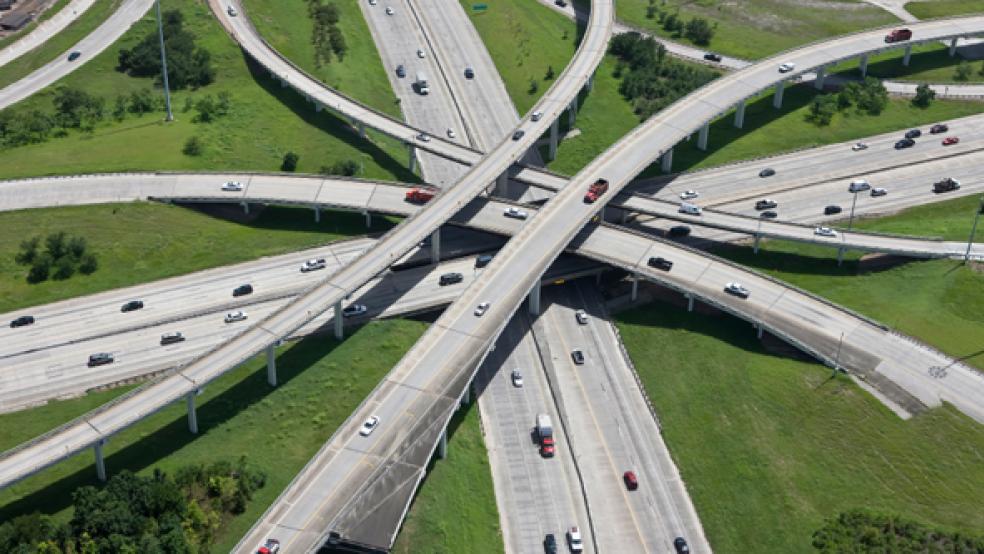Promises of huge increases in federal infrastructure spending were a regular feature of Donald Trump’s presidential campaign, and his inaugural address evoked images of gleaming new airports, modern energy delivery systems and improved highways and bridges. In the White House, he has repeatedly echoed those promises, even announcing an “Infrastructure Week” that, as it turned out, was overshadowed by testimony from former Federal Bureau of Investigation director James Comey about his interactions with Trump.
Now, well past six months into his term, the construction industry would like to know where those infrastructure dollars are. While a slowly improving economy has been helping to improve the fortunes of contractors and associated businesses over the first half of this year, spending by federal, state and local governments has had almost nothing to do with it.
Related: Trump’s Smoke-and-Mirrors Infrastructure Plan
“Construction spending is still increasing overall but growth has become much more uneven across categories in recent months,” said Ken Simonson, Chief Economist for the Associated General Contractors of America in a statement earlier this month. “There has been a steep decline in public investment in nearly all types of construction over the past year. Private nonresidential construction is still rising overall but generally at slower rates than was occurring a few months ago.”
In June, for example, nearly every category of public infrastructure spending tracked by the Census Bureau was down, both compared the month before and to June of 2016. According to Census data, spending on public construction projects in June was down 5.4 percent from May, and 9.5 percent from June 2016, marking the lowest rate of spending, on a seasonally adjusted basis, in more than three years.
The data found that highway and street construction, the largest sector was down 8.1 percent compared to 2016. And at a time when the water crisis in Flint, Michigan, has remained a troubling example of the deterioration of that particular type of public infrastructure, spending on that sector has cratered since 2016, falling 17.1 percent.
Other sectors experiencing declines included sewage and waste disposal, down 16.1 percent, educational institution construction was down 7.1 percent, and spending on transit and airport construction was down 3.9 percent.
Related: Who's Going to Pay for Trump's Huge Infrastructure Plans?
“Washington officials need to act quickly to rebuild our public works before bad roads, unclean water and unreliable power systems begin to serve as a drag on broader economic growth,” said Stephen E. Sandherr, AGC’s chief executive officer.
According to the Journal of the American Association of State Highway and Transportation Officials, the pendulum seems to be moving in exactly the opposite direction.
“Administration officials have repeatedly said details were soon to be released, but lawmakers and industry stakeholders have seen that schedule delayed for months as Congress and the White House spent more time on health insurance proposals,” the organization complained in a recent editorial.
“Meanwhile, Trump in his budget plan proposed cutting various types of federal infrastructure spending, including popular TIGER grants and Essential Air Service subsidies to maintain commercial air travel at rural airports,” AASHTO continued. “Congress is still working on 2018 appropriations for transportation and many other areas of government, and will have little time to complete them when it returns in September from a summer recess. If lawmakers do not complete a new spending measure by Sept. 30 they could extend current-year funding levels, which would delay scheduled increases for highway and transit programs”
For its part, the Trump administration has done little, at least of a public nature, since its ill-fated Infrastructure Week.
Related: America's Civil Engineers Give US Infrastructure a D+
At the time, the president promised to jumpstart spending on infrastructure by beginning an effort to cut the amount of time it takes for construction permits to be issued, announcing a new advisory council that would oversee the changes to existing policy.
“This Council will also improve transparency by creating a new online dashboard allowing everyone to easily track major projects through every stage of the approval process,” Trump said. “To all our state and local leaders here today ... I want you to know that help is finally, after many, many decades, on its way.”
Trump is scheduled to sign a new executive order related to “discipline and accountability in the environmental review and permitting process for infrastructure projects” on Tuesday, though details are thin and the immediate impact of the order unclear.
On the ground, construction firms aren’t seeing evidence of the infrastructure spending surge that the administration promised, and it’s not clear when -- or if -- they will. In its recent analysis of the proposed 2018 Trump budget, the Congressional Budget Office was not optimistic about seeing an increase in infrastructure spending over the next 10 years:
When considering the entire set of proposals in the budget, though, overall spending on infrastructure would not increase by $200 billion. The President’s proposals for discretionary spending would reduce appropriations for other accounts that provide funding for infrastructure, such as those for ground transportation and water resources. Those reductions would largely offset the proposed increase in mandatory spending on infrastructure over the 2018–2027 period.
On the White House website, the “Issues” section dedicated to rebuilding the country’s infrastructure looks exactly the same as it did on June 9, the last day of “Infrastructure Week.”





